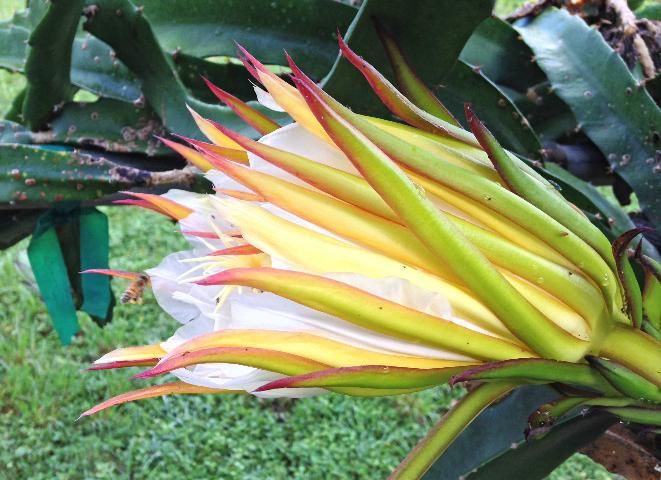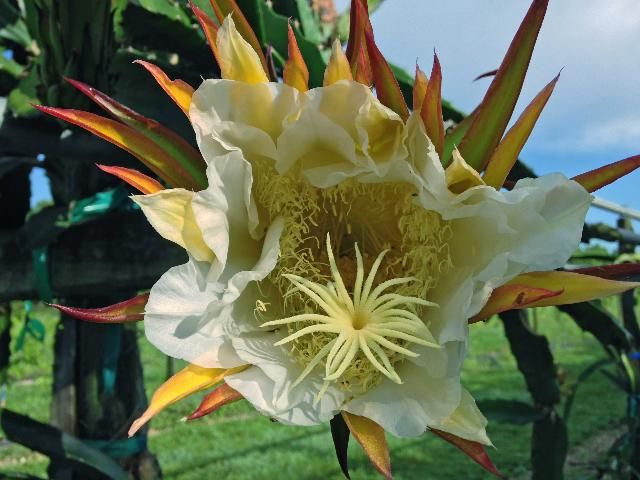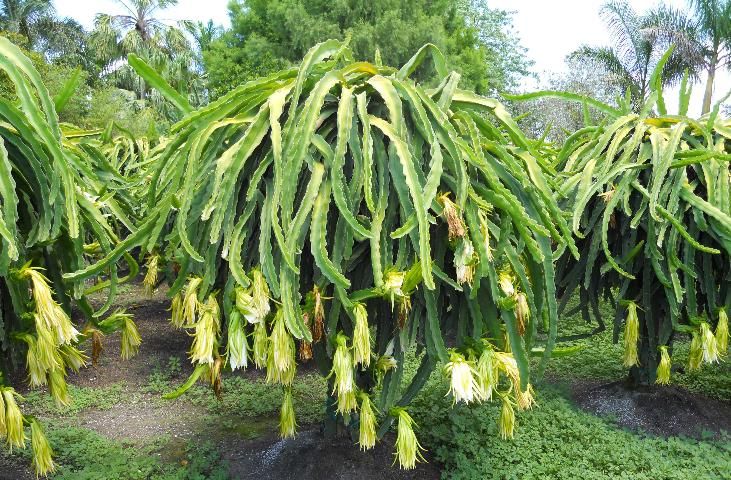
Credit: Ian Maguire, UF/IFAS
Scientific Name: Hylocereus undatus and other species and hybrids (Table 1).
Common Names: English: Strawberry pear, dragonfruit, night-blooming cereus. Spanish: pitahaya, tuna, nopal, pitajaya.
Family: Cactaceae
Origin: Tropical America; southern Mexico, Pacific side of Guatemala, Costa Rica and El Salvador; Venezuela, Colombia, Ecuador, Curacao, Panama, Brazil, and Uruguay.
Distribution: Tropical and subtropical America, south Florida, Caribbean, Hawaii, Asia, Australia, Taiwan, Vietnam, Malaysia, and Israel.
Importance: Since pre-Columbian times, pitayas have been very common in their native countries, where they are consumed by the general population. Recently, pitayas are traded in international markets and have become the most important export fruit of Vietnam. Demand will increase for many years as this delicious fruit becomes better known in other markets.
Description
Plant Stem
Pitaya are fast-growing, perennial, terrestrial, epiphytic, vine-like cacti. They have triangular (3-sided, sometimes 4- or 5-sided), green, fleshy, jointed, many-branched stems. Each stem segment has 3 flat, wavy wings (ribs) with corneous margins and may have 1–3 small spines or be spineless. The stem sections of pitaya form aerial roots that adhere to the surface upon which they grow or climb. The stem may reach about 20 ft (6.1 m) long.
Inflorescence (Flowers)
The flowers are hermaphroditic; however, some pitaya species and cultivars are self-incompatible. The extremely showy, edible, white (pink in other species) flowers are very large, very fragrant, nocturnal, and bell shaped and may be up to 14 inches long (36 cm) and 9 inches wide (23 cm). The stamens and lobed stigmas are cream colored.

Credit: J. H. Crane, UF/IFAS

Credit: J. H. Crane, UF/IFAS
Fruit
The fruit is a fleshy berry, which is oblong and about 4.5 inches (11 cm) thick with red or yellow peel with scales and with or without spines. The pulp may be white, red or magenta depending on the species. Seeds are very small, numerous and black, embedded within the pulp.
Pollination
Self-incompatibility has been reported in several cultivars available from nurseries. To increase the potential for fruit production, plant 2 or 3 different genetic types (not the same clone or variety). Cross-pollination between the different types in the planting will assure a better fruit set and size. Moths and bats are good pollinators, because flowers open at night when there is no bee activity. However, moth and bat pollination has not been commonly observed. Flowers of some cultivars remain open during the early to mid-morning hours and may be visited by bees. Alternately, hand pollination may be done during the night and early morning hours by collecting pollen (or whole stamens) from one flower and applying it to the stigma of other flowers.
Varieties
At the present time, there are a large number of named cultivars and unnamed selections. Many selections have been made and are available in the United States. There are breeding programs in Taiwan, Vietnam, and Israel. In countries where pitaya are native, selections from the wild are being used. Many of these have been introduced into countries that are interested in growing them. Unfortunately, information on the self-incompatibility of these cultivars and selections is not well documented. This makes cultivar (variety) recommendations difficult at best and potentially unreliable.
Climate
Pitayas grow well in tropical and subtropical climates mostly free of frosts and freezes. They tolerate cool or warm climates, provided temperatures do not exceed 100°F (38°C). They tolerate some shade and may be injured by extreme sunlight. They are considered a full-sunlight crop in their native countries. Initial estimates from native areas suggest that optimum temperatures for growth are 65°F–77°F (18°C–25°C).
Insolation (Sunburning). Severe stem damage has been reported from sunburn in some growing regions with low humidity or high altitude. About 30% shading is recommended during the first 3 to 4 months after planting and where insolation is at damaging levels. However, too much shade results in low production and poor-quality fruit.
Cold. Pitayas may be damaged by exposure to below freezing temperatures (31°F; -2°C) of long duration. However, they recover rapidly from light freezing injury.
Wind. Pitayas appear to tolerate windy conditions; however, very strong winds or hurricanes may cause considerable damage to trellises or supports and consequently to the plants.
Salt. Pitayas may tolerate saline soil conditions. Some references classify them from moderate to highly tolerant to salts.
Propagation
Pitaya may be propagated from seed, but fruit and stem characteristics are variable, and the time from planting to fruit production may be up to 7 years. Asexual propagation is preferred, and the use of stem cuttings is widespread. Usually entire stem segments of 6–15 inches (12–38 cm) are used. A slanted cut is made at the stem base, then the cuttings are treated with a fungicide and left to cure (dry and heal) for 7–8 days in a dry, shady location before they are planted directly in the field or in well-drained media in pots. Some propagators apply a root hormone to the cuttings after curing but before planting them. Cuttings grow very fast (1.2 inches [3 cm] per day) and many produce fruit in 6–9 months after planting. Longer cuttings usually reach the trellis supports faster than shorter ones. Pitayas may also be grafted, but this practice is not common. Grafting has potential for selection of rootstocks adaptable to various soil types and problems. Cuttings take about 4–6 months to develop a good root system in pots and be ready for planting.
Production (Crop Yields)
Three- to 4-year-old plants may produce about 220 lb (100 kg) of fruit per year. The life of a pitaya planting is estimated to be about 20 years.
Spacing, Trellising, and Pruning
Trellis
Pitaya plants may become quite large and spreading, and therefore individual plants should be planted 15–25 ft (4.5–6.1 m) or more away from trees, structures, and electrical lines. A strong trellis should be established that may withstand several hundred pounds of stem weight.
A weak trellis may buckle under the weight of a mature pitaya plant. Do not use wires on the trellis because they may cut or damage the stems. If wire is used, it should be covered by plastic hose. For the home landscape, consider a trellis for individual plants, which should consist of a post and a structure at the top of the post to support the plant. An arbor-type trellis may also be constructed. Individual plants growing on a short tree or on a pile of rocks or blocks could also be used as supports for a few plants.

Credit: J. H. Crane, UF/IFAS
Training
Two types of pruning need to be carried out to obtain maximum production of healthy, good-quality fruits. The first one involves training the growing plants until they reach the trellis. This involves eliminating any lateral stems along the main stem until it reaches the trellis, and tying the main stem to the trellis post. Soon after plants reach the top of the trellis, their tips should be cut to induce branching and the new laterals trained and tied to the trellis.
Production Pruning
Pitayas are fast growing and produce extensive growth. If no pruning is done, eventually there will be a very dense mass of stems that will reduce light penetration to the stems and interfere with harvesting the fruits. Furthermore, a dense tangle of stems may result in increased incidence of insect and disease problems. Production pruning involves the removal of damaged, diseased, or dead stems and those that reach the soil. Also remove stems that interfere with cultural practices and harvesting. Selectively remove some stems and train and tie remaining stems to the trellis to prevent stem breakage and crowding. Try to select healthy, strong stems. Pitaya plants are vigorous and may require pruning one to three times per year. Cuts may be treated with a fungicide to reduce the incidence of stem rot. Pruning also induces flowering and stem branching. Prune soon after harvest and remove all pruned stems from the field. The cut stems can be taken to a location away from the field and composted.
Soils
Pitayas are adapted to a wide range of soils provided they are well-drained. They are doing well in the initial plantings in the well drained, calcareous soils of south Florida. As with other fruit crops, they may show minor element deficiencies in the poor, high-pH soils of south Florida. Pitayas thrive in soils high in organic matter or where manure is added.
Planting a Pitaya Cactus
There are two methods of planting; one is to plant a cured cutting directly into the soil. A cured cutting is one in which the cut portion of the stem has been allowed to heal (dry) for several days in the shade. The second and highly recommended system is to plant the cured cuttings in pots, let them develop a good root system for 4–6 months, and then plant them in the landscape. Planting may be done any time in south Florida if an adequate provision for watering is made otherwise, the warm, rainy season is a good time to plant.
Site Selection
In general, pitaya plants should be planted in full or almost full sun (very light shade) for best growth and fruit production. Select a part of the landscape away from other trees, buildings and structures, and power lines. Remember, pitaya plants can become very large if not pruned to contain their size. Select the warmest area of the landscape that does not flood (or remain wet) after typical summers.
Planting in Sandy Soil
Many areas in Florida have sandy soil. Remove a 3 to 10 ft diameter (0.9–3.1 m) ring of grass sod. Dig a hole 3 to 4 times the diameter and 3 times as deep as the container the pitaya plant came in. Making a large hole loosens the soil next to the new tree, making it easy for the roots to expand into the adjacent soil. The use of well-decomposed manure or compost mixed with the native soil dug from the hole is recommended. Carefully remove the plant from the pot so the root ball stays intact, and place the plant in the center of the hole at the same level it was in the pot. Fill the hole with the same soil that came out of the hole, mixed with manure or compost, lightly pressing the soil down halfway before filling and another time when finishing filling in the hole.
Do not press down the soil with your feet, because that may break roots. Build a berm around the plant and water well to fill pore spaces.
Pitaya is a vining cactus and needs a surface to cling to. Because mature plants become very large and heavy, planting adjacent to homes and buildings is not recommended. Planting adjacent to telephone poles or similar utilities is also not recommended and dangerous. Installing a four- to six-inch diameter pressure-treated pole with a strong metal (e.g., rebar) grid attached to the top is best. This trellis should be 10–15 feet away from other plants and structures.
Planting in Rockland Soil
Many areas in Miami-Dade County have a very shallow soil, and several inches below the soil surface is a hard, calcareous bedrock. Remove a 3 to 10 ft-diameter (0.9 to 3.1 m) ring of grass sod. Make a hole 3–4 times the diameter and 3 times as deep as the container the pitaya plant came in. To dig a hole, use a pick and digging bar to break up the rock or contract with a company that has augering equipment or a backhoe. Plant as described for sandy soils.
Planting on a Mound
Many areas in Florida are within 7 ft or so of the water table and experience occasional flooding after heavy rains. To improve plant survival, consider planting pitaya plants on a 2 to 3 ft high by 4 to 10 ft diameter (0.6 to 0.9 m by 1.2 to 3.1 m) mound of native soil. After the mound is made, dig a hole 3 to 4 times the diameter and 3 times as deep as the container the tree came in. In areas where the bedrock nearly comes to the surface (rockland soil), follow the recommendations for the previous section. In areas with sandy soil, follow the recommendations from the section on planting in sandy soil.
Planting in Large Containers
Pitaya plants may be propagated and established in artificial-media-filled containers. The plant container may have the bottom removed and placed on the soil surface (or slightly below) adjacent to the trellis. This avoids having to auger planting holes while allowing some rooting into the soil surface.
Care of Pitaya Plants in the Home Landscape
A calendar outlining the month-to-month cultural prac- tices for pitaya is shown in Table 2.
Fertilizer
Wait about a month after planting or until plants begin to grow to start fertilizing. Fertilization in the first year should be frequent (every 2 months) with light applications of 0.25 lb (118 g) per plant. Use a 6-6-6, 8-3-9, 8-4-12 (palm special) with 2%–3% magnesium or similar formula. The addition of 4 lb (1.2 kg) of well-decomposed manure or compost around the base of the plant but not touching the stem is recommended during the first year. Apply 4–6 minor element sprays from late March to September. Plants growing in high-pH, calcareous soils should be drenched around each plant with 0.25–0.5 oz (7–15 g) of chelated iron. Apply small amounts of ferrous (iron) sulfate at the base of plants growing in neutral and low-pH soils. The rainy, warm season is the best for the application of minor elements. During the second and third year, gradually increase the amount of dry fertilizer to 0.3–0.4 lb (136–182 g) per plant every two months using any of the above formulas. Gradually increase the amount of manure or compost to about 6 lb (2.7 kg) per plant. Use the same number of minor element sprays and gradually increase the iron chelate soil drench to 0.75–1.00 oz (22–29 g) per plant. During the fourth year and after, apply 0.50–0.75 lb (227–341 g) of fertilizer per plant of the above formulas, using 3–4 applications per year and the same minor element and iron chelate recommendations. Apply manure or compost at 5 lb (2.2 kg) each application, twice per year.
Irrigation (Watering)
Although pitayas are members of the cactus family and may withstand dry periods, they have a fairly high water requirement. However, excessive soil moisture will result in the development of bacterial and fungus diseases. A dry period (winter and early spring) is required for abundant bloom induction, but once plants flower (late spring and summer), periods of drought may result in poor production. Therefore, periodic watering is recommended from flowering through harvest.
Pitaya Plants and Lawn Care
Pitaya plants in the home landscape are susceptible to trunk injury caused by lawn mowers and weed eaters. Maintain a grass-free area 2–5 or more feet (0.6–1.5 m) away from the plant. Never hit the plant stem with lawn-mowing equipment and never use a weed eater near the base of the vine. Mechanical damage to the plant stem will weaken the stem and, if severe enough, may cause dieback or kill the plant.
Roots of mature plants spread beyond the drip-line of the plant canopy, and heavy fertilization of the lawn next to pitaya plants is not recommended because it may reduce fruiting and or fruit quality. The use of lawn sprinkler systems on a timer may result in over-watering and cause the cactus plant to decline. This is because too much water too often applied causes root rot.
Mulch
Mulching pitaya plants in the home landscape helps retain soil moisture, reduces weed problems next to the plant stem, and improves the soil near the surface. Mulch with a 2 to 6 inch (5 to 15 cm) layer of bark, wood chips, or similar mulch material. Keep mulch 8 to 12 inches (20 to 30 cm) from the base of the plant stem.
Insect Pests
Some damage by mites, thrips, ants, scales, leaf-footed bugs, mealybugs, and slugs has been reported. Raccoons, possums, rats, and birds may also cause damage to fruit and plants. Please contact your local UF/IFAS Extension agent for current control measures.
Diseases
Several important diseases attack pitayas. These include stem and fruit canker (Neoscytalidium dimidiatum), fruit and stem rot (Colletotrichum gloeosporioides and Bipolaris cactivora), and the bacterium Xanthomonas compestris. Maintaining sunlight exposure and air movement through pruning will allow plants to dry quickly after rainfall and help reduce disease pressure. Please contact your local UF/IFAS Extension agent for current control measures.
Harvest, Ripening, and Storage
Thorny pitayas are more difficult to harvest than thornless ones. Leather gloves and long-sleeved shirts are recom- mended for harvesting thorny pitayas. The ripening season for H. undatus in Florida generally goes from June to November. Hand clippers should be used to remove fruits from the plants. Be careful not to damage the fruit, and remove any stub at the stem attachment by cutting the peduncle (fruit stem) flush to the fruit surface. Harvest only well-colored, mature fruit. Fruit will keep 4 to 5 days at room temperature or several weeks in plastic bags in the refrigerator.
Uses and Nutritional Value
Most pitayas are consumed fresh. However, the frozen pulp may be used to make ice cream, yogurt, jelly, preserves, marmalade, juice, candy, and pastries. Unopened flower buds can be cooked and eaten as a vegetable. Pitaya seeds contain an oil that is a mild laxative. Pitaya are nutritious (Table 3).